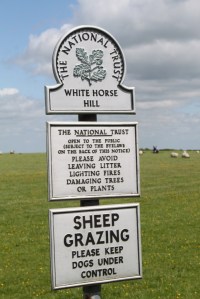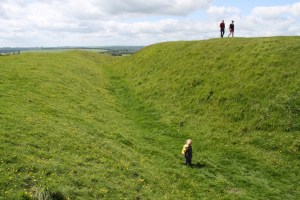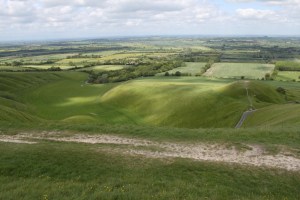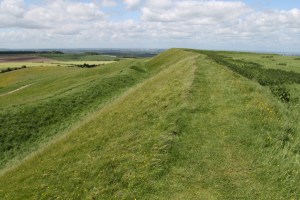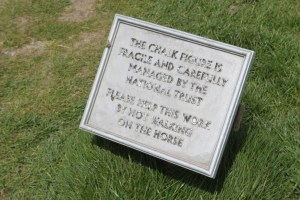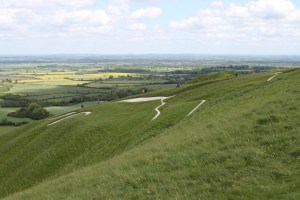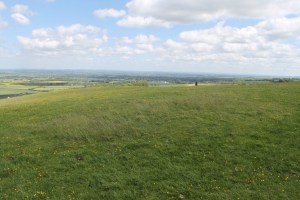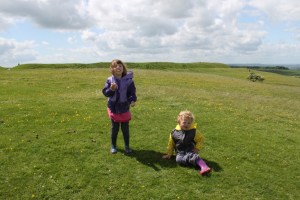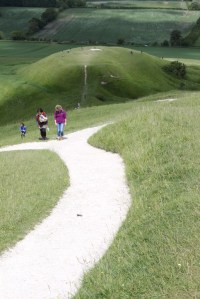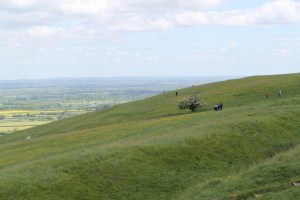From Howard’s Archaeodeath blog.
I want to discuss the tension between tangible and intangible heritage in specific relation to social memory in British landscapes with complex multi-period collections of monuments. My example is White Horse Hill.
This might be old news to many of those working in the profession and academia, but it is something that I have only begun to think about regarding mortuary archaeology and the spaces I am investigating as part of the Past in its Place project; cathedrals, ancient habitations and topographies of memory involving monumental and literary traces.
The textual and material traces of all our sites and landscapes of investigation have dimensions that are still today tangible: including monuments, buildings, memorials. Others are no longer visible but might be apprehended in books. Texts on things, things on text, as well as many, many text-less things and material traces. Yet these dimensions persist and interleave with many traces that are now hidden, stories that are only known indirectly, many intangible dimensions and facets.
Therefore, situated between the tangible and the intangible are traces that are seemingly imperceptible to the casual visitor because of their scale; their grand dimensions or their sleight proportions, as to render them poorly defined as either a fully ‘material trace’ or as an intangible presence. For example, is a management scheme for maintaining grassland through sheep grazing a ‘thing’ that is fully perceptible? Are hut circles, denuded round barrows, field systems only visible from the air perceptible or imperceptible? A bit of both, but in very different ways, is surely part of the answer. For example, a hillfort is both perceptible and imperceptible: some elements are monumental, others only known from archaeological excavation and survey. Other bits have long gone. What is ‘man-made’ and what is ‘natural’ in such a landscape?
My simply point is that navigating these landscapes is about how we encounter what we ‘know’ or ‘understand’ to be there, and that will vary considerably depending on who we are, and what we have read, and who we have talked to.
Let’s take an example. Earlier this summer I visited White Horse Hill; a National Trust managed landscape that contains a rich concentration of prehistoric monuments of various types dating from the Neolithic to the Iron Age, including Uffington Camp and the Uffington White Horse. This is also a landscape shrouded in myth, legend and popular story; imperceptible dimensions that have persisted in literature and other media. I have blogged about this landscape before here and here and here.
Most visitors follow standard routes around this landscape, navigated by the location of car parks, public footpaths, informal pathways marked by wear and use and prior knowledge. There are maps and heritage boards. For some, guidebooks and more detailed reading about the landscape may assist. Some regard this is primary a landscape of antiquity, others might prioritise its beauty and views. For a few it is a place of worship, for many more it holds other values of sacredness. Many use and perceive it as a venue for fun activities, picnics, kite-flying an exercise from walking to mountain biking. So many dimensions interleave, but the monumental dimensions of the archaeology persist in choreographing the visitors and there many perceptions and engagements.
It seems to be a landscape where the monumental triumphs in social memory and in heritage management.
Yet the imperceptible is important too. For example, with my mortuary archaeology hat on, most of the monumental features – whether defined as habitations or ceremonial or in some other fashion, are not principally or exclusively ‘funerary’. Hence, I navigate towards two modest earthworks that are hardly visible and rarely noticed by the vast majority of visitors: a long barrow reused for Roman burial, and a round barrow reused for early Anglo-Saxon burials.
On a busy day for visitors, me and two of my kids sat away from the rest on the Bronze Age barrow reused for early Anglo-Saxon burials and the bodies of later Anglo-Saxon execution victims and we ate some biscuits and other snacks. We navigated the site slightly differently from everyone else. No-one else, at least at that moment, seemed to care they had past two monuments. They hadn’t apprehended them. The hillfort and the white horse, the modified natural shape of Dragon Hill, were their points of departure and encounter.
The point is that these earthworks are now barely visible but may have once been among the most prominent, discrete monumental features in this landscape. Even for archaeologists, this is a very difficult and challenging thing to consider. Might there have been times when these mounds, in their original form or subject to reuse, were key markers in the landscape above and beyond the features we now prioritise and manage?
The fact that no-one visits them today as discrete trajectories, even if they are mentioned in heritage boards nearby, helps to preserve these already denuded features from unwanted treasure-seekers and metal-detecting on what is a landscape protected by law. However, it also foregrounds an odd tension in trying to interpret and communicate the complex landscape palimpsest of prehistory and historic archaeology on and around White Horse Hill. Even many of the monumental traces – the lynchets, the trackways, the barrows, are impercepitble to the modern visitor, overwhelmed by the striking topography itself, the White Horse, and the hillfort.
So where do social memories reside around White Horse Hill? Do only the most monumental of the monumental traces accrue memories and all else is forgotten? And yet how can we call these monumental when they are inherently a mixture of perceptible and imperceptible dimensions? The different monuments are simultaneously tangible and intangible in different fashions. The hillfort is ’empty’ of features to most visitors. The White Horse is visible, prominent, but needs constant maintenance to be retained.
For landscapes like White Horse Hill, the iconic, striking and monumental nature, attracting the visitor and attracting academic discourse, are a blessing but also a curse, swamping and blotting out the complex other traces of the human past revealed and inherent within this landscape.
The dynamic interplay between tangibility and intangibility in landscapes like White Horse Hill wrestle us to think again about how we define what constitutes a ‘material trace’ and how it might (or might not) relate to social memory. How things that were once prominent and key to how landscapes were interpreted, might not be the most prominent today. How do we talk about these landscapes and interpretations of them for visitors that avoid fetishising the surviving monumental traces over the complex material traces and stories that are enmeshed within them.
The conceit of seeing this as a ‘prehistoric’ landscape, is but one of the terrible legacies we have in dealing with complex landscapes such as this one, when so much of what we see is actually the construct of medieval and modern people… The Roman and early medieval use of this landscape is equally fascinating, even if its traces are less monumental today. And features like the White Horse wouldn’t be here today were they not respected, curated or avoided during these later eras. A further conceit is to imagine we see even a fraction of what is there, and that this is anything more than a fraction of what has once been…

